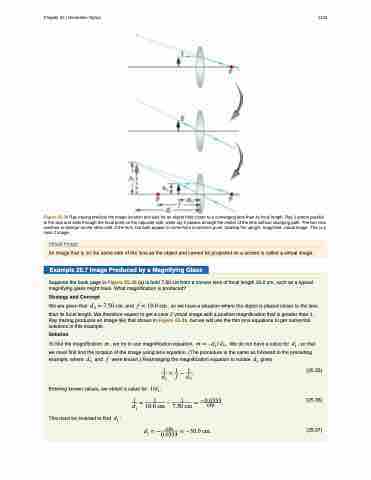Page 1157 - College Physics For AP Courses
P. 1157
Chapter 25 | Geometric Optics 1145
Figure 25.36 Ray tracing predicts the image location and size for an object held closer to a converging lens than its focal length. Ray 1 enters parallel to the axis and exits through the focal point on the opposite side, while ray 2 passes through the center of the lens without changing path. The two rays continue to diverge on the other side of the lens, but both appear to come from a common point, locating the upright, magnified, virtual image. This is a case 2 image.
Virtual Image
An image that is on the same side of the lens as the object and cannot be projected on a screen is called a virtual image.
Example 25.7 Image Produced by a Magnifying Glass
Suppose the book page in Figure 25.36 (a) is held 7.50 cm from a convex lens of focal length 10.0 cm, such as a typical magnifying glass might have. What magnification is produced?
Strategy and Concept
We are given that �� � ���� �� and � � ���� �� , so we have a situation where the object is placed closer to the lens
than its focal length. We therefore expect to get a case 2 virtual image with a positive magnification that is greater than 1. Ray tracing produces an image like that shown in Figure 25.36, but we will use the thin lens equations to get numerical solutions in this example.
Solution
To find the magnification � , we try to use magnification equation, � � ��� � �� . We do not have a value for �� , so that we must first find the location of the image using lens equation. (The procedure is the same as followed in the preceding
example, where �� and � were known.) Rearranging the magnification equation to isolate �� gives �� � �� � �� �
(25.35)
(25.36)
(25.37)
�� Entering known values, we obtain a value for ���� :
� � � � �
�� ���� �� ���� ��
� �������� ��
This must be inverted to find �� :
�� � �
�� � ����� ��� ������


